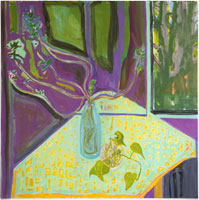
Margaret Tsirantonakis: Inside/Outside Color
It seems I was called for this: To glorify things just because they are.
Czeslaw Milosz
I may not be alone in finding it appropriate and rather handy that new work by Margaret Tsirantonakis should be presented in Stamford while the Museum of Modern Art’s “Abstract Expressionist New York” exhibition is still going on a train ride away. Although the timing is likely unintentional, the relationship between her paintings and those of several of the artists represented in the MoMA exhibition is inescapable. This is not to suggest that Tsirantonakis’ work is simply an offshoot of the celebrated work of the New York School. On the contrary, she has found her own way, her own clear voice, having looked hard at some of the very same ancestral figures (Matisse and Bonnard) admired by members of the New York School, and she has also taken in and absorbed several of the breakthrough developments in painting that are associated with the Abstract Expressionists themselves.
Although Tsirantonakis tells us that her work results from direct observation, there’s obviously more going on here than meets the eye when looking out at the Yale & Towne building, or studying the bric-a-brac and plant life of her light-filled studio. She acknowledges the transformation of this imagery: the way each painting “becomes its own entity,” referring to her original observations, but standing “apart” from them, as well. What accounts for these transformations?
It has been suggested that because Tsirantonakis was born in Crete, and frequently returns there for nourishing visits, that the light and colors of that charmed place most likely play a role in both the imagery (occasional Greek pots and other classical motifs) and treatment of the subjects in her work. In a similar vein, Bob Dylan is reported to have observed about the Irish folk musician, Tommy Makem, that “when Tommy sang, there was an elsewhere in his eyes where the singing came from.” One suspects, then, if her work is thought about in this way, that when Tsirantonakis looks at a potted plant her assessment of it is overlaid with information coming from other plant forms that aren’t necessarily at all apparent in her studio. It’s as if she’s translating the language of the plant life in front of her into another language of distinctly different plant forms, color values and emotional pitch.
Another possible explanation for why Tsirantonakis’ work ultimately “stands apart” from what she has observed is the compelling influence on her work of the paintings of other artists. Just as Rothko was especially admiring of Bonnard’s palette and the formal compositions of his domestic interiors, Tsirantonakis’ paintings demonstrate Bonnard’s influence on the way in which she positions the objects in a room within her paintings, and the colors she introduces, which are neither immediately present in her studio, nor integral to the actual still life objects she’s portraying.
Finally, and, for me, the most crucial, but elusive, explanation for these transformations has to do with Tsirantonakis’ inner life and personal vision as projected on to these works . As with the forceful model of Pollock’s engagement with the unruly forces of nature and their expression through abstract means, her renderings of tree branches and flowers are highly charged emotionally. One may even feel that the plants themselves, twisting and turning, hastily pruned and truncated, are expressing emotions to which she is uniquely attuned, poised to capture.
The intimate scale of Tsirantonakis’ paintings and works on paper is well suited to the imagery she employs and its impact on the viewer, heightening the sensation of compression and confinement we experience. Each canvas is a nearly unrelenting echo chamber for the markings and riotous colors associated with its various still life objects. The backgrounds, fragmented shards of color and feverish drawing, against which vases, plants, and other objects are placed, offer little visual relief from the turbulent forms for which they serve as backdrops. Views through windows and doorways break down all distinctions between inside and outdoors. The mood and emotional energy are pervasive. There is no escaping the unsettling energy of these normally familiar and calming domestic anchors.
Jeffrey Hoffeld